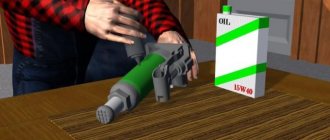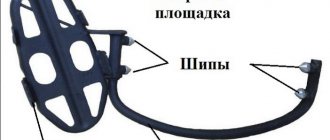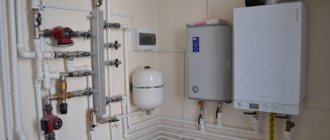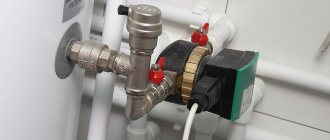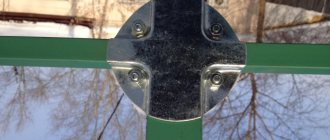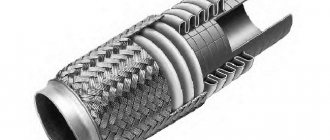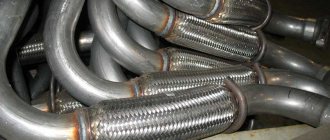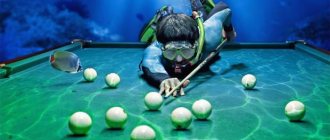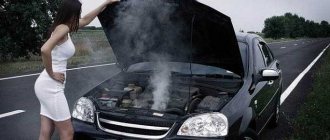Dampers are used to reduce the shock load at the end of the rod stroke. With low impact energy, rubber rings perform this role. In large cylinders, a system is used to cut off part of the air with its subsequent slow flow through the throttle.
Pneumatic cylinders are devices for linear movement of the working body of machine tools and other mechanisms. Unlike rotary-type actuators, which have a rather complex design, pneumatic cylinders consist of a hollow sleeve, inside of which a rod moves with the help of compressed air, creating a retracting and pushing effect on the mechanisms.
Dampers are used to reduce the shock load at the end of the rod stroke. With low impact energy, rubber rings perform this role. In large cylinders, a system is used to cut off part of the air with its subsequent slow flow through the throttle.
Based on the operating principle, this type of equipment can be divided into the following types:
- single-acting cylinders;
- double acting cylinders.
A single-ended cylinder has one inlet and has a power stroke in only one direction, while a double-ended cylinder, which has inlets on both sides, allows a power stroke in two directions.
According to the number of final positions of the piston, pneumatic cylinders can be:
- two-position, that is, having only two extreme fixed positions;
- multi-position, allowing the working element to be fixed in several positions between two extreme positions.
Depending on the purpose, pneumatic cylinders can have different designs of structural elements.
You can learn more about the most common types of pneumatic cylinders and their symbols here.
Operating principle: the piston of a pneumatic cylinder creates a pulling or pushing movement, moving along with the rod when compressed air is supplied to one of the cylinder cavities and the other cavity is connected to the atmosphere.
Piston pneumatic cylinders are actuators for converting the energy of compressed air into reciprocating movement of the rod.
Operating principle: the piston of a pneumatic cylinder creates a pulling or pushing movement, moving along with the rod when compressed air is supplied to one of the cylinder cavities and the other cavity is connected to the atmosphere.
As a rule, pneumatic cylinders (with the exception of some series) are standardly equipped with damping devices at the end of the stroke with adjustable braking intensity.
All pneumatic cylinders are equipped as standard with a magnetic ring on the piston, which allows the use of non-contact magnetic sensors.
Pneumatic cylinders come in single-acting and double-acting types. In single-acting pneumatic cylinders, return is carried out using a spring. The spring-loaded cavity is connected to the atmosphere through a breather.
To control single-acting pneumatic cylinders, three-line distributors are used. To control double-sided pneumatic cylinders, pneumatic distributors 5/2, 5/3 are used.
Let's consider these options sequentially.
3. Regulation of the speed of pneumatic cylinders
Flow regulators (throttles) with a check valve allow you to change the air flow when it moves in one direction and do not limit the flow in the opposite direction. This feature can be used to set different speeds of movement of the pneumatic cylinder piston in the forward and reverse directions.
Two different layouts of throttles with a check valve are possible when regulating the speed of the pneumatic cylinder rod:
- regulation of the flow rate when supplying air to the cylinder (in this case, the air flow rate for discharge is not limited);
- regulation of the flow rate when releasing air from the cylinder (in this case, the air flow rate for supply is not limited).
Let's consider these options sequentially.
Flow control when supplying air to the cylinder
When using this control method, the exhaust air will leave the pneumatic cylinder faster than the supplied air, since the use of throttles only allows to reduce the air flow, but not to increase it. This leads to the fact that in one of the chambers of the cylinder the pressure is close to atmospheric. This situation is shown in Figure 5: port P1 is connected to the atmosphere, compressed air is supplied to port P2, the cylinder rod moves to the left.
Figure 5 – Flow control when supplying air to the cylinder
This pressure distribution inside the cylinder has the following consequences:
1. The cylinder’s perception of load in the direction of movement of the rod deteriorates. This happens because the pressure in the cylinder chamber, towards which the movement is carried out, is close to atmospheric, and it does not offer resistance to movement in this direction.
2. At low speeds, the rod begins to move jerkily. The fact is that the flow of air entering the cylinder is limited, and the volume of the chamber increases as the rod moves. Together with different values of the static friction force and the sliding friction force, this leads to pressure fluctuations inside the cylinder and uneven movement of the rod.
3. It becomes impossible to stop the cylinder rod in intermediate positions using valves 5/3 center closed. As can be seen in Figure 5, one of the cylinder chambers is under pressure, but the second is not. Therefore, when the 5/3 control valve is moved, the center is closed to the middle position, the cylinder will inevitably continue to move until the pressure in both chambers is balanced.
Flow control when venting air from the cylinder
When using this control method, air is supplied to the cylinder at a maximum flow rate, and the air flow rate when discharged into the atmosphere is limited, i.e., air can enter the cylinder faster than it leaves it. With this control scheme, the pressure in the relief chamber of the pneumatic cylinder is maintained during the movement of the rod (Figure 6, port chamber P1).
Figure 6 – Flow control when venting air from the cylinder
This method of regulation has the following features:
1. The pneumatic cylinder accepts load well, both co-directed with the movement of the rod and having the opposite direction, since both chambers of the cylinder are under pressure.
2. Compared to the previous control scheme, it becomes possible to achieve slower movement speeds while maintaining smooth stroke of the rod.
3. Stopping the rod in a given position is simplified. Since both chambers of the cylinder are under pressure, when they overlap, the cylinder quickly reaches an equilibrium state. This significantly reduces the distance traveled by the rod from the moment the cylinder ports are closed until the rod stops completely.
It follows that regulating the flow rate when venting air from the cylinder is preferable
compared to regulating the flow rate when air is supplied to the cylinder.
To carry out the reverse stroke, it is necessary to supply compressed air to the rod end, and connect the piston end to the atmosphere. Under the action of compressed air pressure, the piston will move and the rod will retract. The force developed by the pneumatic cylinder during the reverse stroke can be calculated using the formula:
Fittings with adjustable air flow
By changing the flow of air entering the pneumatic cylinder or the flow of air leaving it, we can regulate the speed of the cylinder. For this purpose, special fittings with flow control, also called throttles, are used. Let's consider the design of the throttle using the example of the MV 34 .. .. /B fitting (Figure 2). The flow regulator fitting has a constriction 3, to which the regulating element 2 is connected using a micrometric screw 1. Thus, by rotating the screw, the size of the flow section of the fitting and, consequently, the flow through it changes. Figure 2 also shows the designation of this fitting on pneumatic circuits.
Obviously, installing such fittings on both ports of the pneumatic cylinder (P1 and P2) will not allow you to independently control the speed of forward and reverse stroke of the cylinder rod, since the throttling of the air flow when passing through the fitting occurs in both directions. As a result, the speed of the rod movement will be limited by the lowest air flow.
Figure 2 – Fitting with flow adjustment series MV 34 .. .. /B
To independently control the speed of forward and reverse stroke of the pneumatic cylinder rod, flow regulator fittings with a check valve are used. Their designation on pneumatic circuits is shown in Figure 3a. When air flows from left to right, the check valve is closed and air does not pass through it (red arrow in Figure 3b). The air passes through a throttling device, with the help of which the flow rate is adjusted (blue arrow in Figure 3b). When air flows from right to left, the check valve opens and the main part of the air flow passes through it (red arrow in Figure 3c). Some air continues to flow through the throttling device (blue arrow), however, this has virtually no effect on the overall air flow.
Figure 3 – Operating principle of a throttle with a check valve
Thus, the use of throttles with a check valve provides regulation of flow when air moves in one direction and maximum flow when air moves in the opposite direction. Therefore, when installing flow regulator fittings with a check valve, the switching direction indicated on the pneumatic diagram should be observed. As a rule, on the fitting itself there is a conventional graphic designation, which makes it clear in which direction the air flow is regulated, and in which the full flow is ensured. For example, Figure 4 shows the location of such a designation for fittings with flow control MV 21 and MV 34.
Figure 4 – Flow regulator fittings with check valve
Double acting pneumatic cylinders
In double-acting pneumatic cylinders, compressed air is supplied both to the piston cavity and to the rod cavity.
Pneumatic cylinder with one-way rod
Double-acting pneumatic cylinders with a single-sided rod are most widely used due to their simplicity of design, versatility, ability to regulate forward and reverse speed, and compactness.
Pneumatic cylinder design
In the presented design, the lids and sleeve are tightened with 14 anchors (studs) with 15 nuts.
Basic Concepts
The schematic diagram of a pneumatic cylinder is shown in the figure.
When describing the operation of a pneumatic cylinder, the following terms are most often used.
The piston cavity is the chamber between the piston and the rear cover.
The rod cavity is the space between the piston and the front cover.
Direct stroke - movement of the piston when pressure is applied to the piston cavity.
Reverse stroke is the movement of the piston when emptying the piston cavity.
The active chamber is a pressure chamber.
Dead volume is the space remaining between the front and rear covers and at the extreme positions of the piston.
Effective area is the area of the piston that is affected by compressed air pressure.
Operating principle
Compressed air from a compressor or other source is supplied to the piston cavity of the pneumatic cylinder, the rod cavity at this moment is connected to the atmosphere using a distributor, the pressure of the compressed air acts on the piston, causing it to move until it rests against the front cover. The pneumatic cylinder makes a straight stroke, its rod extends. The force developed by the pneumatic cylinder during forward stroke can be calculated using the relationship:
- where p is the compressed air pressure
- D - piston diameter
To carry out the reverse stroke, it is necessary to supply compressed air to the rod end, and connect the piston end to the atmosphere. Under the action of compressed air pressure, the piston will move and the rod will retract. The force developed by the pneumatic cylinder during the reverse stroke can be calculated using the formula:
- where p is the compressed air pressure
- D - piston diameter
- d—rod diameter
The direction of compressed air flows into the piston and rod cavities, as well as their connection to the atmosphere or discharge line, is carried out using special devices - pneumatic distributors.
Illustration of the operation of a pneumatic cylinder
| Retract the cylinder rod | Extend the cylinder rod |
Pneumatic cylinder with double-sided rod
The sizes of effective areas and volumes of cavities during forward and reverse strokes of a pneumatic cylinder are different. This means that, other things being equal, the pneumatic cylinder will move at different speeds and create different forces during forward and reverse strokes. This is not always a desirable phenomenon.
If the pneumatic cylinder must act equally in both forward and reverse strokes, then use a pneumatic cylinder with a double-sided rod.
Pneumatic actuators use designs with a fixed sleeve or with a fixed rod. In the second case, compressed air is supplied to the working cavities through the rod.
Double-acting telescopic pneumatic cylinder
The telescopic design, in which each subsequent rod is installed inside the previous one, can significantly reduce the dimensions of the pneumatic cylinder. This is true for those cylinders whose stroke exceeds the piston diameter by 10 times. In double-acting telescopic pneumatic cylinders, compressed air enters the working cavities through holes made in the rod.
Fasteners will help mount pneumatic cylinders . They are available for lids and for stems.
Pneumatic cylinders are actuators of pneumatic systems and are designed to convert the energy of compressed air into mechanical linear movement. Go to the table for calculating the force of a pneumatic cylinder.
Main characteristics of the supplied pneumatic cylinders:
- Double-acting piston pneumatic cylinders;
- Can be equipped with adjustable damping in end positions;
- Pneumatic cylinders are produced with diameters of 12, 16, 20, 25, 32, 40, 50, 63, 80, 100, 125, 160 and 200 mm and rod stroke from 25 to 2000 mm;
- It is possible to install a magnetic ring on the piston for non-contact determination of its position using reed sensors.
Types of supplied pneumatic cylinders:
Piston pneumatic cylinders are designed to convert the energy of compressed air into reciprocating movement of the rod. When compressed air is supplied to one of the cavities of the cylinder and the other cavity is connected to the atmosphere, the piston moves together with the rod, creating a pushing or pulling force.
Diaphragm pneumatic cylinders are used for control types of pipeline fittings.
Pneumatic cylinders are divided into single-acting and double-acting cylinders, with a single-sided or double-sided (through) rod; they come in piston and membrane types.
In double-acting pneumatic cylinders, the rod moves under the action of compressed air in the forward and reverse directions. For such pneumatic cylinders, both forward and reverse strokes are working. However, the force developed by a double-acting pneumatic cylinder during reverse stroke is lower than the force developed by the cylinder during forward stroke.
If it is necessary to control the movement of the rod with the piston, a magnetic ring is installed on the piston. A reed switch sensor . When the sensor is triggered, the LED on it lights up.
Fasteners will help mount pneumatic cylinders . They are available for lids and for stems.
- We list the main ones for covers: Trunnion, flange, supports.
- For stem: Fork, earring, hinge
On the website you can see drawings of pneumatic cylinders and prices for pneumatic cylinders. Technical specialists will help you calculate the pneumatic cylinder, as well as all elements of pneumatic circuits. Products are delivered throughout Russia; you can also pick up the goods yourself from a warehouse in St. Petersburg or Moscow.
The use of mechanisms and systems that operate on pneumatic cylinders is very widespread. If you clearly define your goal, you can choose a pneumatic cylinder of any shape and design. It is also worth noting that when choosing the optimal size and shape of pneumatic cylinders with an increased piston stroke, it is necessary to take into account the resistance of the rod.
Pneumatic cylinders are used to convert the energy of compressed air into linear mechanical movement. Basically, piston pneumatic cylinders are designed to convert compressed air into the movement of a piston rod. The principle of operation of a pneumatic cylinder is as follows: compressed air is supplied to one of the cavities of the cylinder, and the piston together with the rod moves and creates a pushing force. By the way, on the resource https://www.ru.all.biz/ you can choose pneumatic cylinders for your needs.
In cylinders that operate on the double-acting principle, the rod moves under the action of compressed air in all specified directions. For cylinders of this type, forward and reverse strokes are working. It is worth noting that the force that the pneumatic cylinder develops in reverse stroke is significantly lower than the force it develops during forward stroke.
The use of mechanisms and systems that operate on pneumatic cylinders is very widespread. If you clearly define your goal, you can choose a pneumatic cylinder of any shape and design. It is also worth noting that when choosing the optimal size and shape of pneumatic cylinders with an increased piston stroke, it is necessary to take into account the resistance of the rod.
If necessary, you can mount and install a system of a certain number of pneumatic cylinders with different piston stroke lengths. In the case when there is not enough space for installing a pneumatic cylinder, and its diameter does not allow obtaining the required force. This problem is solved by installing two or more cylinders in series, which will create force and work on one rod. In this case, the pressure will increase proportionally and depend on the number of working cylinders in the system.
Good afternoon, experts! Tell me, does anyone know how to implement constant pressure in a pneumatic cylinder, provided that the piston rod extends and retracts?? In general, there will be a roller on the rod and this roller should slide along the plane and press on it with constantly the same pressure, and the plane has differences in height (2-4 centimeters), and the point is that the roller should press in all places with the same pressure ( approximately 1 Atmosphere)
Very useful video. It was very helpful in understanding how this device works. Could you give me some advice? I came across this problem (when air is supplied to the piston cavity and the rod is lifted all the way out of the rod cavity, air is poisoned without stopping, and the same thing when working in the opposite direction, it poisons until the air in the receiver runs out, does this mean that there is a violation between these cavities tightness?). Thank you in advance.
The 2 main trump cards of such a stray are effort and movement. force is a direct dependence on the diameter and stroke-length of the working part .. rod run-out. Well, speed always depends on the power of the air arrival. Another important thing is the size of the metal itself. It is clear that the more metal there is in it, the more load it will take..
Good afternoon, experts! Tell me, does anyone know how to implement constant pressure in a pneumatic cylinder, provided that the piston rod extends and retracts?? In general, there will be a roller on the rod and this roller should slide along the plane and press on it with constantly the same pressure, and the plane has differences in height (2-4 centimeters), and the point is that the roller should press in all places with the same pressure ( approximately 1 Atmosphere)
You all actually know how to speak Russian. I would read this in a smart book. say it in your own words for us downs
What strength should the compressor be? Thank you……
Golden rule: select a pneumatic distributor based on the highest instantaneous flow parameters required by the cylinder. The distributor flow rate must match the rod speed requirements. Do not use average l/min.
Calculation of force and pressure of a pneumatic cylinder
Pneumatic cylinder
The golden rule is that the theoretical force value of the selected cylinder should be 25% greater at high speed, 50% greater at low speed, and 100% greater at the slowest rod positioning speed.
The golden rule is to choose the correct fitting sizes, pipe sizes and shortest pipe lengths to minimize cycle times and reduce energy consumption.
Distributor
Golden rule: select a pneumatic distributor based on the highest instantaneous flow parameters required by the cylinder. The distributor flow rate must match the rod speed requirements. Do not use average l/min.
The graph gives an idea of typical flow ranges corresponding to various Norgren valve sizes. Flow rates are shown in a vertical line, with an inlet pressure of 6 bar and an outlet pressure of 5 bar (with a pressure drop of 1 bar).
Fittings with adjustable flow for different installation methods
When considering the design and operating principle of fittings with flow control, two models of such fittings were mentioned: MV 21
and
MV 34
(see Figure 4). The design of the fitting-regulators allows them to be easily mounted on the panel. Therefore, these models are convenient to use in cases requiring prompt adjustment of the operating speed of pneumatic cylinders.
However, in some cases, operator control of the speed of operation of the pneumatic cylinders is not only unnecessary, but can also have negative consequences. For example, incorrect settings of interacting mechanisms can lead to incorrect operation of the entire installation. To limit the access of operating personnel to devices for regulating the speed of pneumatic cylinders, there are modifications of fittings with flow control, mounted directly on pneumatic cylinders or on distribution valves. Figure 7 shows the appearance and pneumatic diagrams of such fittings.
Figure 7 – Fittings with flow control with check valve
Fittings series MV 41 with letters /C
and
/V
differ from each other in the direction of installation of the check valve.
Fittings of modification MV 41.. .. /C
are intended for installation on pneumatic cylinders
(C – cylinder)
, modifications MV 41.. ..
/V
– for installation on valves
(V – valve)
.
The direction of installation of the check valve in fittings of this series is selected in such a way as to ensure flow control when air is released from the cylinder
.
Figure 8 shows pneumatic circuits for adjusting the speed of forward and reverse stroke of the rod of the Vesta NWT 050.0100 pneumatic cylinder, controlled by the VALMA PIV-SA-14 valve.
- If it is convenient to regulate the speed directly on the pneumatic cylinder itself, you should use MV 41 .. .. /C
, which are installed on the cylinder (Figure 8a). Blue arrows show the direction of air movement in the throttles during forward stroke, red arrows - during reverse stroke. It can be clearly seen that in both cases, regulation is carried out when air is released from the cylinder. - If it is convenient to carry out regulation at the distribution valve, you can use fittings MV 41 .. .. /V
(Figure 8b) or muffler fittings with flow control MV 11 .. ..
-VE
, MV 14 .. ..
/B
( Figure 8c). - If flow regulators need to be mounted separately, for example, on a panel for quick operator access, you should use the MV 21 .. .. /U
or MV 34 .. ..
/U
(Figure 8d).
Figure 8 – Flow adjustable fittings with check valve
More drawings and projects on this topic:
Composition: 3D Assembly, Detailing, Assembly drawing (AS), Specification
Contents: 3D models with drawings of all details of Option 28 from the album Bogolyubov S.K.
Contents: 3D assembly, 3D models of each part, drawing of the assembly and each part.
Composition: 3D Assembly, 3D models of all parts.
Date of: 2016-12-03
Views: 5 233
103
Add to favorites
Source
Student club "Technician". A unique site with diplomas and coursework for techies.
All sections / Drawing and computer graphics /
Task Option 18 Air cylinder
Kind of work:
Drawings
File formats:
COMPASS
Submitted to the educational institution:
St. Petersburg Institute of Mechanical Engineering
Description:
Task option 18 PMIG.ХХХХХХ.018 SB Air cylinder
option 18 Air cylinder detailing option 18 Air cylinder drawings option 18 Air cylinder assembly drawing
Part and assembly drawing task
1.Complete the preparation of the assembly drawing and specification.
2. Make three-dimensional models and associative drawings of body 1 and oil seal cover 4. In each associative drawing, place an axonometry with a cutout of one quarter of the part.
Description of the air cylinder An air cylinder is a device installed in the brake system of rolling stock.
Piston rings 6, made of cast iron, serve to seal the piston. Piston 2 is secured to rod 3 with a nut 13, a washer and a cotter pin.
In housing 1, at the exit point of the rod 3, there is a sealing device (oil seal) 21, which prevents air from leaking through the gap between the rod and the hole in the oil seal cover 4. The packing material can be hemp, linen cord, or asbestos. Due to the elasticity of the packing material and the cones at the ends of the seal, the packing is pressed tightly against the rod. The packing material loses its elasticity over time, so it is necessary to periodically compact it. This is achieved by tightening the nuts on the studs 17.
PMIG.ХХХХХХ.018 SB_Air cylinder PMIG.ХХХХХ.018 SP_Air cylinder PMIG.ХХХХ01.018_Body PMIG.ХХХХ01.018_Body axonometry PMIG.ХХХХ02.018_Piston PMIG.ХХХХ03.018_Ш current PMIG.ХХХХ04.018_Gland cover PMIG.ХХХХ05.018_Cover PMIG.ХХХХ06. 018_Piston ring PMIG.ХХХХ07.018_Sleeve PMIG.ХХХХ08.018_Gasket
Made in compass 3D V13 drawings + 3D models
Assembly drawing of a pneumatic cylinder
BGATU Department: Engineering Graphics Assembly drawing of a pneumatic cylinder Minsk 2013
The drawing was made according to “Bogolyubov S.K. Reading and detailing assembly drawings. Mechanical Engineering, 1986. - 84 p.: ill. Methodological instructions, examples of drawings and individual tasks for detailing, grouped according to complexity into two groups,” Code MCh00.28.00.00.SB. The assembly drawing of a pneumatic cylinder consists of: left cover, right cover, cylinder, piston, flange, pneumatic cylinder assembly.

